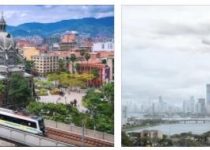Attractions in La Paz, Bolivia
La Paz, Bolivia: Bolivia’s metropolis at lofty heights
With a location between 3200 and 4100 meters, La Paz is the highest seat of government in the world. Neither backpackers nor study travelers should miss out on La Paz. The mixture of Spanish colonial heritage, colorful markets and old Indian cultures is impressive. Every year the folkloric Gran Poder Festival in La Paz delights tourists and locals alike. In 2016 it will take place in May. At this festival, Christian and ancient Indian traditions, dances and costumes mix into a colorful spectacle.
Typical La Paz
- The city may not be the capital, Sucre, but it is the economic, political and cultural center of the country
- A colorful hodgepodge of people lives here – the indigenous indigenous population, criollos – they are descended from the Spanish colonial rulers -, mestizos, i.e. mixed race and Europeans, shape the cityscape
- In the street scene, business outfits meet old traditional costumes
- “Ch’ama” – a beer that is brewed in La Paz from coca leaves, among other things, and is said to alleviate altitude problems.
Attractions in La Paz
Basilica San Francisco – Probably the most beautiful baroque church in the city is a must for all visitors to La Paz. Study travelers interested in art history will be delighted and you can expand your knowledge in the museum next door. The crypt is also worth a visit. From the roof there is a fantastic view of La Paz. It is wonderful to experience the mass on Sunday with the locals in their old costumes.
Calle Jaen – one of the prettiest streets in La Paz, you feel transported back into old colonial times, a street with a lot of atmosphere. The Casa de Murillo is worth a visit here. Today a museum – the former house with its delightful courtyard housed the freedom fighter Pedro Domingo Murillo.
Hexenmarkt – around the Calle Santa Cruz, healers, herbalists and magicians sell their various exotic remedies, potions and powders against evil spirits and to appease Pachamama, mother earth. But – if you visit this place, you should leave all valuables in the hotel.
Santo Domingo Church – with fine examples of Indian stone carving
Mercado Rodriguez – It is the largest food market in La Paz. The sellers are Cholos or Cholas, the descendants of mixed marriages between Spaniards and Indigenas, native Indian women. Their colorful traditional costumes delight the hearts of the photographers.
Museo de metales preciosos – It is also known as the Gold Museum and a magnet especially for study travelers. Millennia-old treasures from different time periods and cultures are exhibited here. The main attraction is the treasure of San Sebastian. It consists of various pieces of jewelry that are assigned to the Tiahuanaco culture, the first South American high culture.
Museo de la Coca – In this museum the traveler learns everything about the history of the coca leaves.
National Museum of Art – Study travelers and art enthusiasts should visit this museum. It is housed in a historic mansion from the 18th century and features artifacts from the pre-Hispanic and colonial times as well as works by contemporary local artists.
Paseo el Prado – the “main artery” of La Paz with old colonial buildings and the monument to Simon Bolivar, the famous South American freedom fighter. The street leads directly to Plaza Murillo.
Plaza Murillo – this is where the classical parliament building and the cathedral are located in classical architecture and with very beautiful glass windows.
This also speaks for La Paz:
The location of the Bolivian city in the west of the country is perfect as a starting point for other sights such as Lake Titicaca, the Valle de la Luna (Valley of the Moon), the World Heritage Site Tiahuanaco and the Altiplano.
Important when traveling to La Paz:
Anyone who has booked a study trip, for example, should allow themselves a little time to get used to the thin air in La Paz. It makes little sense to plunge into a tight program immediately after arrival. After all, the airport here is also the highest in the world.



